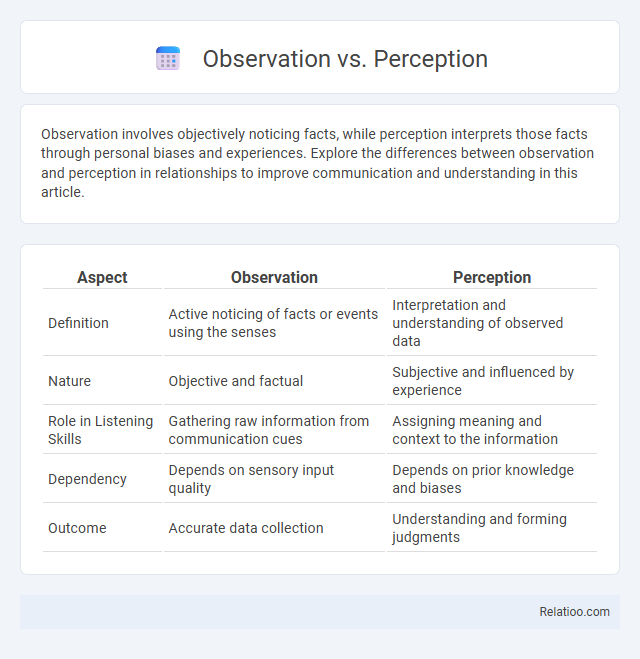Observation involves objectively noticing facts, while perception interprets those facts through personal biases and experiences. Explore the differences between observation and perception in relationships to improve communication and understanding in this article.
Table of Comparison
| Aspect | Observation | Perception |
|---|---|---|
| Definition | Active noticing of facts or events using the senses | Interpretation and understanding of observed data |
| Nature | Objective and factual | Subjective and influenced by experience |
| Role in Listening Skills | Gathering raw information from communication cues | Assigning meaning and context to the information |
| Dependency | Depends on sensory input quality | Depends on prior knowledge and biases |
| Outcome | Accurate data collection | Understanding and forming judgments |
Understanding Observation: The Act of Noticing
Observation involves the active process of noticing and gathering sensory information from the environment, serving as the foundational step in acquiring data. Perception interprets and organizes these sensory inputs into meaningful patterns, influenced by prior knowledge and context. Understanding observation as the act of noticing emphasizes its role in detecting raw, unprocessed details essential for accurate analysis and decision-making.
Defining Perception: Interpretation Beyond Senses
Perception involves the brain's interpretation of sensory input, transforming raw observation into meaningful experiences by incorporating context, memory, and emotion. Unlike mere observation, which is the passive act of noticing stimuli, perception actively constructs reality by assigning significance and understanding to sensory data. This cognitive process enables individuals to navigate complex environments through personalized meaning rather than objective detection alone.
Key Differences Between Observation and Perception
Observation involves the direct sensory experience of facts or events, relying on objective data collected through sight, sound, or other senses. Perception interprets these sensory inputs, influenced by individual cognitive processes, emotions, and prior knowledge, resulting in a subjective understanding of the observed phenomena. The key difference lies in observation being a passive reception of information, while perception actively constructs meaning from that information.
The Role of the Senses in Observation
The role of the senses in observation is critical, as they serve as the primary channels for gathering raw data from the environment. Observation involves detecting stimuli through sensory organs, such as the eyes, ears, and skin, enabling the initial intake of visual, auditory, and tactile information. Perception processes and interprets this sensory input, transforming basic observations into meaningful experiences by applying cognitive functions and past knowledge.
Cognitive Influence on Perception
Observation involves the passive gathering of sensory data, while perception actively interprets this data influenced by cognitive processes such as memory, attention, and expectations. Cognitive factors shape perception by filtering and organizing sensory inputs, leading to subjective experiences unique to each individual. This interaction demonstrates that perception is not a mere reflection of reality but a complex cognitive construction shaped by prior knowledge and mental frameworks.
Observation in Everyday Life
Observation in everyday life involves actively noticing and recording sensory information from your environment, forming the basis for understanding and decision-making. It differs from perception, which is the brain's interpretation of these sensory inputs, and cognition, which includes higher-level processes like reasoning and judgment. Sharpening your observation skills enhances accuracy in recognizing details and responding appropriately to situations around you.
Perception and Personal Bias
Perception shapes how you interpret sensory information, heavily influenced by personal bias that filters and distorts objective observation. Unlike observation, which involves direct, unbiased data collection, perception reflects subjective meaning assigned to those observations based on prior experiences and beliefs. Understanding the distinction helps minimize bias and enhances accurate assessment of reality.
How Culture Shapes Perception
Culture profoundly shapes your perception by influencing how sensory information is interpreted and understood, filtering observations through learned beliefs, values, and experiences. While observation refers to the objective act of noticing phenomena, perception involves the subjective process where cultural context assigns meaning and significance to those observations. This cultural lens affects cognitive patterns, emotional responses, and social interactions, demonstrating that perception is not merely a reflection of reality but a construction shaped by cultural frameworks.
Enhancing Observation Skills for Better Understanding
Enhancing observation skills sharpens your ability to notice fine details and subtle changes, crucial for accurate data gathering and improved analysis. Perception interprets these observations, but strong observation ensures the raw information is reliable and rich in context. Mastering observation techniques boosts your overall understanding, enabling more precise decision-making and problem-solving.
Real-Life Examples: Observation vs Perception
Observation involves gathering raw sensory data, such as noticing a red light while driving, whereas perception interprets that data, leading you to understand that the red light means stop. In real life, two people may observe the same scene--a person waving--but perceive it differently based on context, one thinking it's a greeting and the other a sign of distress. Your ability to distinguish between observation and perception can improve decision-making by recognizing how your mind interprets sensory input beyond the facts seen.

Infographic: Observation vs Perception
 relatioo.com
relatioo.com